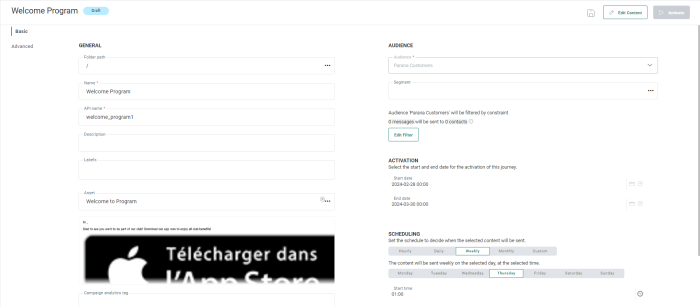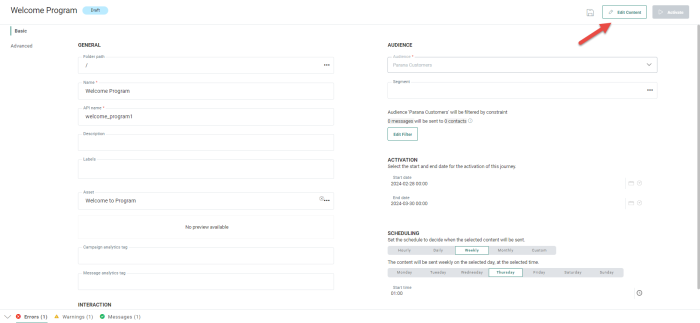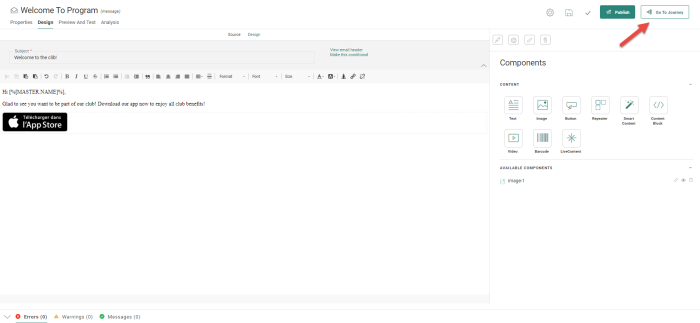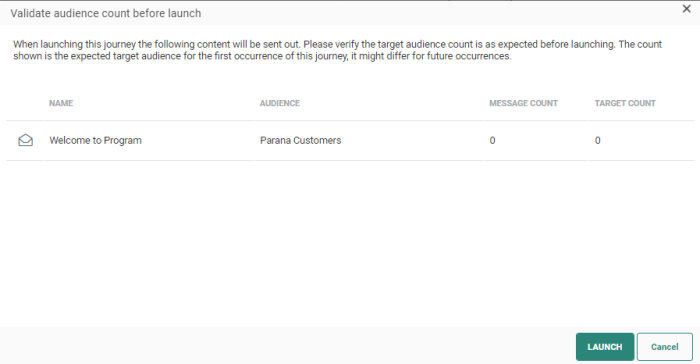Recurring Batch Journeys are typically used to send the same messages at regular time intervals for a certain period of time. For example, you could use a Recurring Batch Journey to send a Birthday message every day at the same time, to contacts in the audience having their birthday that day. The user can set the time frame in which the journey must be executed and can select a segment of the audience to target with the recurring message.
Create the Recurring Batch Journey
Recurring Batch Journey Properties
Editing Content in the Journey
Launching the Recurring Batch Journey
Create the Recurring Batch Journey
To create a Recurring Batch message, perform the following steps:
1. Go to the Journey entry, and from the fly-out menu select New and then Recurring Batch from the wizard.
Set the following properties:
- Folder Path — This is the folder in which the asset is created. By default it takes the folder that is currently selected on the Start page when the asset is created. You can modify the path if required. Click the folder field to access the dialog and select a different folder.
- Name and Description — Set a name and description for this Recurring Batch Journey. The name is used in reports, Start pages, etc.
- API-Name — Set the API-Name for the Recurring Batch Journey. This name is used when the journey is executed via the API.
- Label — The label(s) assigned to this asset. Select one or more labels from the drop-down. (These labels are configured in the Admin configuration.) Users with the proper Access permissions can also create new labels here by typing the new label value in the field.
- Content — Select the message that needs to be sent in a recurring way (birthday message, password update reminder, Welcome message). An Asset selector is available to choose the content from. You can use email messages, mobile push messages, SMS and MMS. When the message is selected a message preview is presented. The audience of the message is also the audience of this journey.
Note: When choosing a content that uses assets in a folder with no access, a warning explains that this content cannot be selected.
- Campaign & Message analytic tag — The values entered for these analytic tags are passed on to a tracker when a tracker is activated.
2. When done, click Next. A page is displayed to set the details for this journey:
3. Audience — The audience is pre-filled based on the selected message audience. You can decide if this message is sent to the complete audience or only to a selection of the contacts in the audience. An audience count tells you how many contacts are targeted.
The ![]() icon provides additional details about:
icon provides additional details about:
- The languages available
- The fallback for contacts without a language or with a different language
- Audience limited to contacts with these languages
- Unsubscribes excluded
If segments exist for the selected audience, they can be selected from the Folder selector. You can choose from static and dynamic segments. The audience count is automatically updated when a segment is selected.
Note: If the selected list is configured to require segment selection, you MUST select a segment for this list. The journey won't be executed as long as no segment has been selected.
In addition, you can apply filters to the audience. Click the Edit Filter button to open the Audience filter dialog where a constraint can be defined. This constraint can use fields from the following sources:
- The selected Audience List, including 1:1 and 1:n linked lists
- Any profile extension linked to the audience.
- Behavioral data (based on Engagement Metrics and Interest tags: mails sent, delivered, viewed, clicked and last viewed, clicked, delivered)
- Historical channel interaction data registered in Custom Journeys, Recurring Batch, Single Batch and AB Journeys
- Segments of the selected audience by including or excluding records in the selected segment
For more information on how to build constraints and use them, check out the topic Constraint Builder.
Note: The Constraint Builder for the segment definition does not allow to create complex filters. For instance, a filter that compares the birthday of a contact with the date of today. For these kind of more complex filters, we advise to create the segment on the Audience List itself and use this audience segment in the message.
4. Activation — Set the time frame in which this journey is active: Select a start and end date and time. Click the calendar icon to set a date and the clock to set the time of scheduling.
5. Scheduling — Click a button to configure the recurring moment in time when the journey will be sent. This can be:
- Minutes — The message is sent every time the set number of minutes has elapsed. Use the Custom time frame option to define the start and end time in between which this rule needs to be executed. For example, send the message every 30 minutes between 09h00 and 17h00.
- Hourly — The content is sent every hour
within the activation period.
Note that the sending of the first batch will happen immediately, when the journey is launched. - Daily — Send at a given time in the day (e.g., Every day at 08:00)
- Weekly
— The journey is executed on one or more selected days of the week. The time at which the execution can take place can be different per selected day. For example, send the message every Tuesday at 12h00 and every Thursday at 17h00.

- Monthly — For the monthly execution, there are 2 different ways of selecting the days. Use the toggle Specific days to select your preferred option.
When the toggle specific days is off, you can select the days of the month and the time of the day. For example, the 5th, 15th and 25th at 09h00.
When the toggle is on, you can select the weekday and the time on that day the message should be sent. More than one weekday can be selected. To indicate which weekday of the month , options are available to choose the first, second, third, fourth or last one of the month. Example, the first and third Monday at 09h00, and first and third Wednesday at 17h00.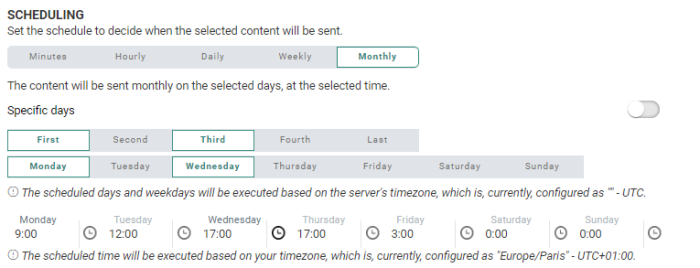
Note: When a user defines a scheduled launch time on a journey, the time is expressed in their time zone. The journey will be launched in the time zone of this user at that time.
When a user with a different time zone views the journey, the scheduled time will be translated to their time zone, to reflect the local time.
Internally, the system uses a universal time zone, to make it possible to translate times to localized versions for every user. This means that updates by one user will be correctly represented in the local time zones of all other users.
Example:
User A has a time zone that is set to UTC -5 (Eastern Standard Time).
They schedule a journey to be launched at 6:00 local time (UTC -5).
User B has a user time zone that is set to UTC +1 (Romance Standard Time).
They see a scheduled launch time of 12:00 for that same journey, as their local time has a 6 hour difference compared to user A.
Note: When no start date is set for the activation of the journey, activating it will cause the content to be sent from the moment it's activated, with the scheduled time (hourly, daily, weekly, monthly, custom) still taken into account.
For example :
A Recurring Batch Journey without start date set, is scheduled to run daily at 1 pm (13:00).
- If this journey is launched (activated) today at 10 am (10:00), then the first execution will be today at 1 pm (13:00), as scheduled.
- If this journey is launched (activated) today at 2 pm (14:00), then the first execution will be tomorrow at 1 pm (13:00), as the scheduled time for today has already passed.
6. Interaction — Activate the option if the message can be sent multiple times to the same contact. This is for instance required when a password reset message is sent every month.
Note: The option is by default activated.
7. When done, click Create journey. The journey properties page is displayed.
Recurring Batch Journey Properties
You can still make modifications to this journey in the Properties page.
In the navigation bar on the left , a Basic and Advanced entry are available.
Basic
This is a summary of the properties set during the creation. Check out the above for more details on these properties.
Advanced
This lets you set additional properties:
Audience pre-calculation
For some customers, it is beneficial to pre-calculate the audience for an action in a journey well before the actual go-live, or when there’s less load on the environment. The actual journey execution will use the pre-calculated audience when it’s available to save time. The option is by default disabled.
- When — Only displayed when the audience pre-calculation is activated. You can choose from following options:
- Time before execution — The audience is calculated at a specific time interval (expressed in minutes) before the journey is executed. The journey must be scheduled in this case.
- At a fixed time — The audience is calculated at a specific day and time.
- When a task finishes — The audience is calculated when the selected task is finished. You can select a task from a drop-down list of tasks.
- When a task succeeds — The audience is calculated when the selected task succeeds. You can select a task from a drop-down list of tasks.
Deduplication
If there are duplicate contacts in the journey's audience, you can use Deduplication to select a unique contact based on a field or a combination of fields. This avoids sending the email more than once to the same contact because the contact is in the Audience List more than once.
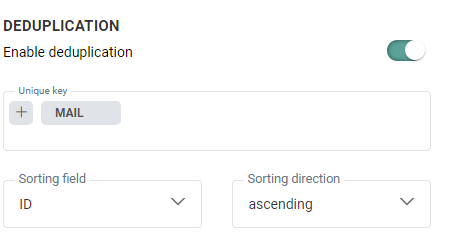
For each journey you can define if deduplication should be activated.
Unique key — You can define the field in the audience that should be used to perform deduplication. This can be a combination of fields as well, for example the name and email for a contact can be used to detect duplicates.
Note: A maximum of 5 fields can be selected. Fields of type longtext, boolean, float and datetime are not allowed.
Prioritization — Here you define what field in the audience should be used to define the record that has priority over the others in case duplicate records are found. For example, you can use the last update date as a prioritization rule.
Sorting — Choose from ascending or descending to define the record that should be kept.
When done, click Save.
Sending limit
The number of records that should be targeted by the journey can be limited to only a sample of the records. Activate the option to target only a sample of your audience.
Amount — Defines the number of contacts in the list that should be targeted. You can choose from the following:
- Absolute — Target an absolute number of contacts, ex. a sample of 100. An additional option is available to indicate what this means when there are multiple executions. If you select the option 'on multiple executions, this is the total amount of users to target', the amount entered is applied over all executions.
- Percentage — Target only a percentage of the contacts, ex. a sample of 10% of the target.
Note : 'on multiple executions, this is the total amount of contacts to target' is only available when setting an absolute number, while it becomes disabled when setting a percentage.
Example: For a sending limit of 100, at every execution a sample of 100 records will be targeted.
Selection — Defines if the sample records need to be selected randomly or if the records first need to be sorted. You can choose between the following:
- Random — Select the records randomly.
- Sort by — Sort the records by a selected field in the list, either ascending or descending.
Example: Select 'Sort by' and 'descending' for the Creation_Date field, to return the most recent records first.
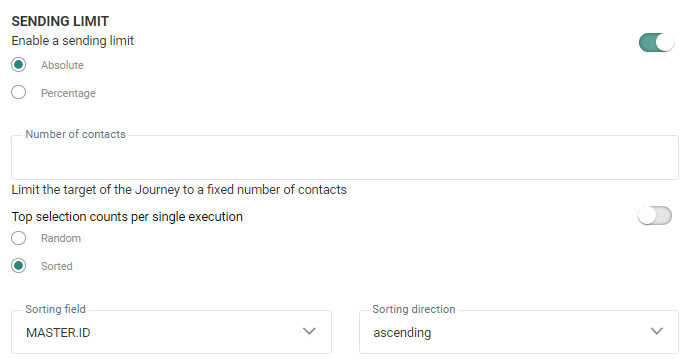
Journey Tracking
In some cases you don't need the journey to be tracked.
For example, a 'Password reset' journey does not require tracking.
Two options are available:
- Interaction tracking
- External analytics tracking
By default, these trackings are enabled. Toggle the option off to disable the tracking.
Interaction tracking
Interaction covers email opens, email clicks, link tracking(emails and pages), and unsubscribe tracking. Disabling this will ensure all these interactions are not logged. This will have an impact on:
- Journey reporting
- Segmentation based on journey metrics
- Send-Time Optimization
But this will not have an impact on:
- Unsubscribe functionality — So when contacts unsubscribe, this will still work
External analytics tracking.
External analytics tracking covers all the external trackers like for example Google UTM, Site tracker, Shop tracker.
When this type of tracking is disabled, no parameters from external trackers will be added to domain related links and hence the information can not be used by the external tracker. This will have an impact on:
- External analytics — e.g. Google analytics
- Site CRM identification — The m_bt parameter will not be added for domain links and hence CRM identification will not be done
- Shop tracker — The parameters that are added for the shop tracker will not be added and hence this will have an impact on revenue reporting
Cadence
Journeys can be added to a Cadence Plan so that communications over the different channels happen in a controlled way, respecting the rules of the plan. By activating the Cadence functionality and selecting a plan from the drop-down, marketers can now add journeys to a Cadence Plan. When a journey is added to a plan, it is at the lowest priority. If you want to change this, you need to go to the Cadence Plan priority tab and change the order of the journey in the list.

Note: The user needs access right for Cadence to be able to do this and the journey needs to be published
Journey Execution priority
When multiple journeys are scheduled for execution at the same time, it is now possible to ensure that one journey will take priority over another. Some journeys might be more time sensitive or important than others, and this option allows you to prioritize journeys. By default the priority of the journey is set to medium, but priorities can range from low, over medium and high, to very high.
Example:
Journey A with high prio is scheduled at 09h00, Journey B with Medium priority is also scheduled at 09h00. Journey C with high priority is scheduled at 09h01.
Journey A is executed first. When execution is finished, Journey B and C are in the queue, but Journey C has higher priority than B and will be executed before Journey B.
Custom Fields
This section is only displayed in the Advanced properties when a message of type SMS is used in the journey. These custom fields are retrieved from the SMS endpoint used for the organization.
Editing Content in the Journey
When you create a Recurring Batch Journey using a message, you have the possibility to make changes to this message, while creating the journey.
1. To do so, use the option Edit content in the Journey toolbar.
Note: When moving away from the journey to the content, you are prompted to either save the changes to the journey, move to the content without saving any changes in the journey or canceling.
2. The Message editor is launched where you can modify the message according to the needs. (For more information on how to add content to a message, check out this section)
3. To return to the journey, click the button 'Go to journey' in the toolbar.
Note: When changes are made and the message is used in other journeys, these changes will also impact those journeys.
Launching the Recurring Batch Journey
If the journey is ready for execution, click Activate.
When launching the journey, you are informed about the content that will be sent, the audience and filter applied and the number of contacts that will be targeted. A dialog is displayed with this information. The counts displayed in the dialog take into account the deduplication of records as well as the sending limit defined for the journey
Note: This dialog is displayed only for users who have the right of Audience validation. This right is set by default for every user.
You need to confirm that the audience count is as expected and then launch the journey. If the count is not yet available, you can only cancel the journey launch.
Note: The journey will be visible from the Journey Start page in a dedicated section. From the Start page, the journeys can be edited, deleted, or pinned.
Pausing the Journey
When pausing the journey, links in emails and pages will remain available. Only the sending of messages is paused. While a journey is paused, changes can be made, saved, validated and published. The journey can then be resumed, and newly processed messages will contain the changed content.
Example: A Recurring Batch Journey is launched every Saturday. However, when only one email per day is allowed and another journey needs to be executed once on that Saturday, it is now possible to pause this Recurring Journey for a few days and then resume it again.
The toolbar contains an additional Pause button that becomes available after the journey was launched.

A paused journey can be activated again or taken offline completely.
Canceling the Journey
It is possible to cancel a journey after it has been launched. As long the journey processing is not finished, you can cancel the journey.
Canceling the journey will stop sending out the new emails but if currently something is still being processed, best effort is made to ensure these will not be delivered to the inbox of the recipients. Also, all links in already sent out emails will continue to work. The status of the journey will be available from the status bar at the top.
When you cancel a Journey different alerts are displayed, depending on the execution status of the journey:
Some messages have been processed: A progress bar gives a very clear and visual representation of what has been processed. You can choose to cancel or keep the journey running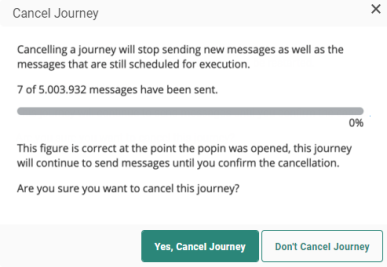
No processing data is available yet: You can choose to cancel the journey anyway or keep the journey running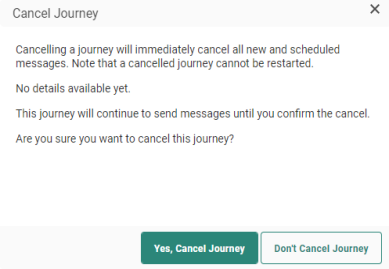
All messages have been processed: In this case, canceling is no longer possible, and the user is informed.
Note: Canceled journeys cannot be resumed.
Taking the Journey Offline
When taking a journey offline, no messages are sent and links in emails and pages will no longer be available.
The toolbar contains an additional 'Take offline' button that becomes available when the journey has been activated.
An offline journey can be activated again or paused.
Reactivating the Journey
While a journey is pausedor taken offline, it's possible to edit the content through the journey by clicking on the corresponding 'Edit content' button.
If you don't publish the content after you made changes to it, returning to the journey and reactivating it, shows a pop-up explaining that there are unpublished content changes.

- Click OK to launch the journey with the last published version of the content (without the most recent non-published changes to the content).
- Click CANCEL to go back to the journey wizard and publish, if needed, your last content changes. That way, you can choose to reactivate the journey once more and launch it with the updated published version of the content.
Example : Creating a Recurring Batch Journey with Complex Constraints
Note that the video may not reflect the latest changes/updates, and will be updated in the near future.



